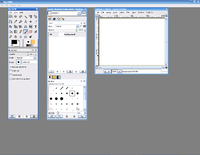GIMPshop
|
A screenshot of GIMPshop on Windows XP | |
| Developer(s) | Scott Moschella |
|---|---|
| Stable release |
2.2.11 (based on GIMP 2.2.11)
/ May 17, 2006 |
| Development status | On hold |
| Operating system | Mac OS X, Linux, Microsoft Windows, Solaris |
| Type | Raster graphics editor |
| License | GNU General Public License |
| Website | sourceforge.net/projects/gimpshop.mirror |
GIMPshop was a modification of the free and open source graphics program GNU Image Manipulation Program (GIMP), with the intent to replicate the feel of Adobe Photoshop.[1] Its primary purpose was to make users of Photoshop feel comfortable using GIMP. According to the developer, Scott Moschella:
My original purpose for GIMPshop was to make the GIMP accessible to the many Adobe Photoshop users out there. I hope I’ve done that. And maybe along the way, I can convert a Photoshop pirate into a GIMP user.[2]
History
GIMPshop was created by Scott Moschella of Next New Networks (formerly Attack of the Show!) as an unofficial fork of GIMP. He encountered resistance from GIMP's lead developers due to the methods he employed to implement his hacks.[3] GIMPshop was originally developed for Mac OS X and is a Universal Binary. It has also been ported to Windows, Linux, and Solaris.
Features
GIMPshop shares GIMP's feature list, customisability, and availability on multiple platforms, while addressing some common criticisms regarding the program's interface: GIMPshop modifies the menu structure to more closely resemble Photoshop and adjusts the program's terminology to match Adobe's. Due to the interface changes, many tutorials for the popular Photoshop can be followed in GIMPshop without modification, and others may be adapted for GIMPshop users with minimal effort. All of GIMP's own plugins (filters, brushes, etc.) remain available.
Being based on GIMP, GIMPshop cannot generate CMYK output files by default.[4] Users who need to generate color separations require additional software, since commercial printing requires CMYK, not RGB color channels. A workaround is available through the Separate+ plugin,[5] which is not included in the base installation.
In the Windows version, GIMPshop uses a plugin called Deweirdifyer to combine the application's numerous windows in a similar manner to the MDI system used by most Windows graphics packages. This essentially adds a unifying background window that fully contains the entire GIMPshop UI. More compatibility with Photoshop can be achieved using a third-party add-on for GIMP that supports Photoshop plugins, called pspi, which runs on Microsoft Windows or Linux.[6]
For Mac OS X, GIMPshop is compatible only with Panther (10.3.x) and Tiger (10.4.x). It requires the X11.app (based on the X Window System display protocol) to render the user interface. Newer versions of X11 are no longer compatible with GIMPshop.
Status
GIMPshop was based on the old GIMP 2.2.11, and is not current with the latest GIMP codebase. In order to maintain usability, some users have taken to manually updating GIMPshop's libraries themselves.[7] Due to pending concerns over rights to the GIMPshop name, and a dispute with the individual who purchased the gimpshop.com domain, plans for an update are on hold. As explained by Moschella:
Not more than a few days after the OS X version was released and spread virally, someone who isn't me bought "Gimpshop.com", put up a site with hot-links to the files on my site and began advertising - LOTS of advertising. Soon, there were donate buttons, my name in the site's title and much more - making it look like my website.I asked that the owner stop hot-linking my files (and draining my bandwidth), so he hosted them somewhere else. I questioned his motives and he said he was just a fan and that the site was a "fan-site".
It has been five years, the software has stagnated (due in no small part to my becoming discouraged by this one profiteer who trumped me, stole much of my traffic and bumped my site down to the second result when you search for "Gimpshop"). I assumed the guy would just give it up as I sadly let the project stagnate, but that hasn't happened.[8]
In a March 2014 discussion,[9] Moschella states:
I originally created Gimpshop, but I'm not the jerk who owns that domain and added adware & spyware to the source. Sorry about that. I hate that this guy is out there making my fun little project into an abomination.….
I don't have a project site for it. I became discouraged after this whole ordeal and I let it slip away into obscurity. …. Gimpshop was a fun little 'prank' that got bigger than I ever expected. Sad what it has become, though.
See also
References
- ↑ "Gimpshop". PC World. Archived from the original on 14 June 2012. Retrieved 2009-03-05.
- ↑ "Announcing GIMPshop". Plastic Bugs. Archived from the original on February 16, 2009. Retrieved 2009-03-05.
- ↑ "A GIMP In Photoshop's Clothing :: OSDir.com :: Open Source, Linux News & Software". www.osdir.com. Retrieved 2009-03-05.
- ↑ "Glossary". The GIMP Help Team. Retrieved 9 February 2012.
- ↑ Yamakawa, Yoshinori. "Separate+". Yoshinori Yamakawa. Retrieved 9 February 2012.
- ↑ "PSPI: Running Photoshop plug-ins in GIMP". Tor Lillqvist. Retrieved 2010-10-19. Archived May 6, 2015, at the Wayback Machine.
- ↑ "GIMPshop on Snow Leopard". www.strayprocess.com. Archived from the original on February 12, 2010. Retrieved 2009-11-14.
- ↑ Moschella, Scott (1 February 2010). "What are my intellectual property rights here?". ask.metafilter.com. Archived from the original on 23 January 2012. Retrieved 23 January 2012.
- ↑ "I haven't tried it myself so can't vouch for it but GimpShop fills a similar niche". YCombinator. Hacker News. 27 March 2014. Retrieved 14 July 2014.
